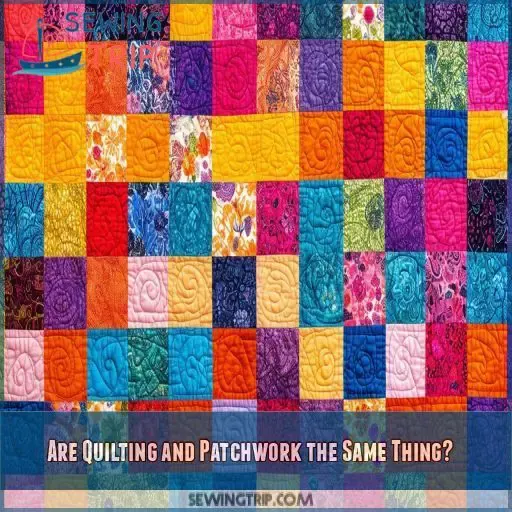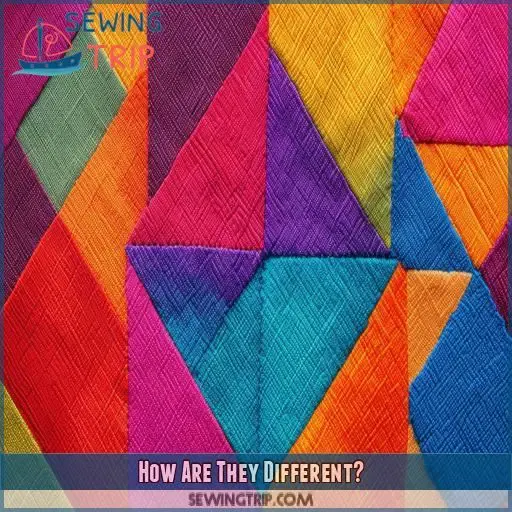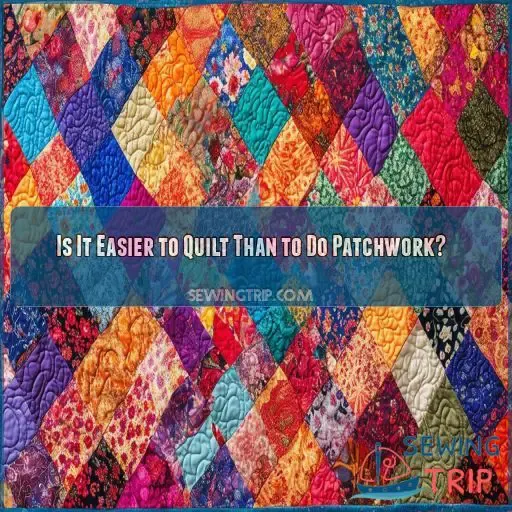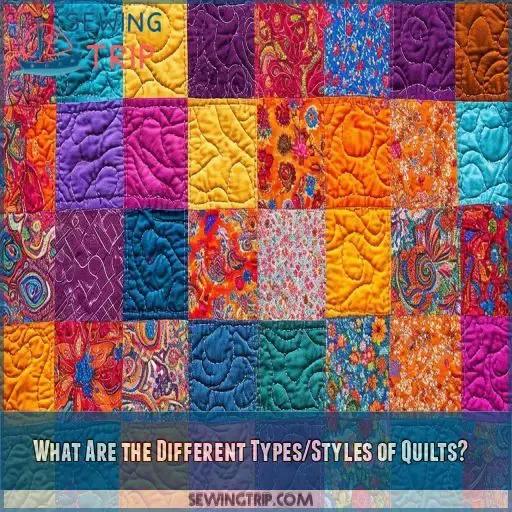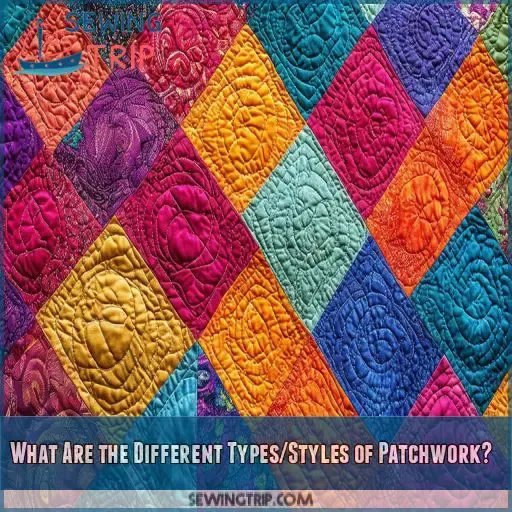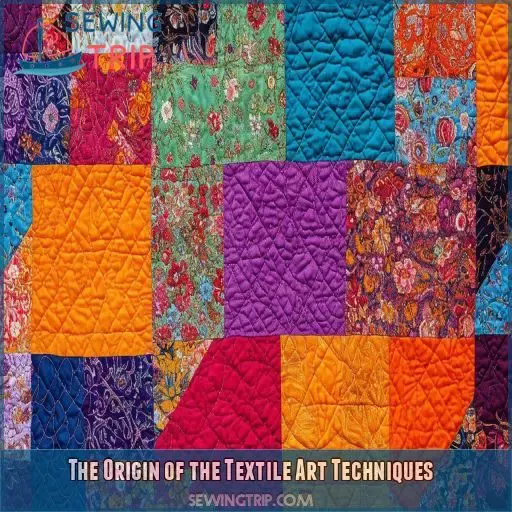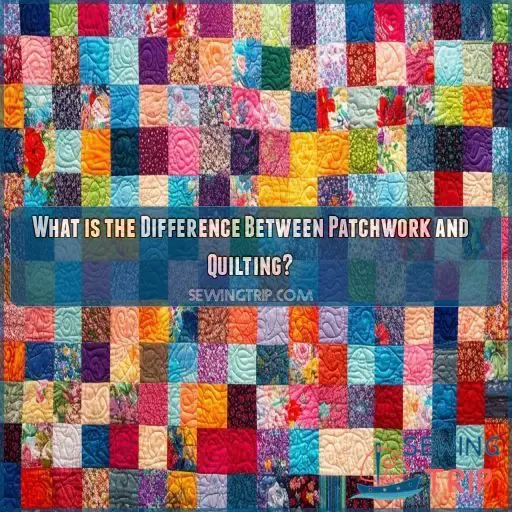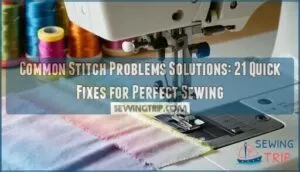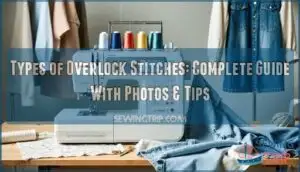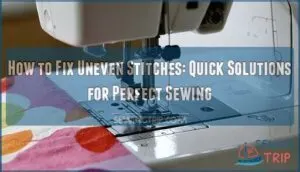This site is supported by our readers. We may earn a commission, at no cost to you, if you purchase through links.
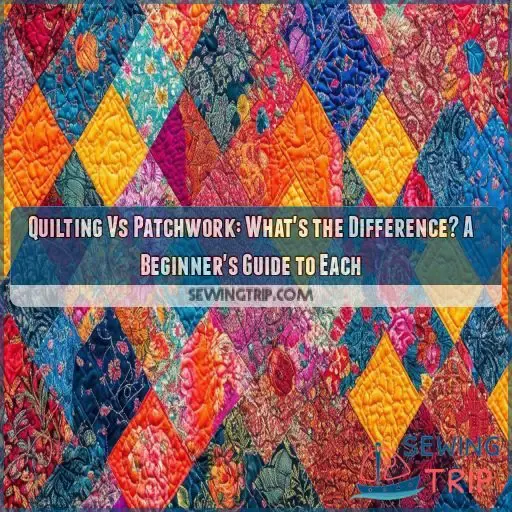 Patchwork and Quilting are two distinct crafts with their own unique histories and sewing techniques.
Patchwork and Quilting are two distinct crafts with their own unique histories and sewing techniques.
Despite this, they are often confused for one another.
Quilting, for example, involves sewing three layers of fabric together to create a bed covering.
Patchwork, on the other hand, entails stitching pieces of fabric together to form a new object.
Beginners may struggle to differentiate between the two.
Table Of Contents
- Key Takeaways
- Is Patchwork the Same as Quilting?
- Are Quilting and Patchwork the Same Thing?
- How Are They Different?
- Is It Easier to Quilt Than to Do Patchwork?
- What Are the Different Types/Styles of Quilts?
- What Are the Different Types/Styles of Patchwork?
- The Origin of the Textile Art Techniques
- What is the Difference Between Patchwork and Quilting?
- Frequently Asked Questions (FAQs)
- Conclusion
Key Takeaways
- Patchwork and quilting differ despite sharing similarities in patterns and techniques.
- Patchwork involves stitching fabric pieces together to form designs, whereas quilting focuses on sewing three fabric layers to create a cohesive structure.
- Quilting often serves functional purposes like insulation and warmth, while patchwork is primarily a domestic art form used for decorative items.
- Patchwork patterns emphasize the arrangement of fabric pieces, contrasting with quilting patterns that highlight the stitching process.
Is Patchwork the Same as Quilting?
Quilting and patchwork are distinct textile art forms with overlapping histories and aesthetics. Quilting involves stitching three fabric layers—the top, batting, and backing—for warmth and insulation. Patchwork, on the other hand, focuses on stitching smaller fabric pieces together to create decorative designs. While quilting is a more intricate craft with a broader range of techniques, patchwork is simpler and more accessible for beginners. Quilting is often used commercially, while patchwork is more commonly employed for domestic purposes like home decor.
Despite their differences, quilting and patchwork share some similarities and a rich historical background.
Are Quilting and Patchwork the Same Thing?
While quilting and patchwork may seem similar, they’re distinct textile art forms. Quilting involves layering fabrics and stitching them together, while patchwork focuses on arranging and sewing fabric pieces into intricate designs.
Usage
Quilting and patchwork have distinct historical and modern uses. Quilting, with its layering technique, was originally used for insulation in garments and bed coverings. Patchwork, on the other hand, was a hobby that utilized old fabric pieces to create new, decorative items for the home.
Technique
Quilting and patchwork employ distinct techniques. Quilting involves sewing three layers of fabric together, while patchwork focuses on stitching smaller pieces of fabric to form a larger design. Here are some key technique differences:
- Quilt batting: Quilting uses a middle layer of batting for insulation, creating a puffy look.
- Applique stitching: Quilting often features applique stitching, sewing small, decorative pieces onto the fabric.
- Fabric selection: Quilting typically uses a broader array of fabrics, reflecting its commercial applications.
Pattern
Now, let’s explore the realm of patterns and designs. Patchwork patterns showcase a stunning array of options, from the 3D allure of Cathedral Window to the monochrome magic of Stained Glass and the triangular twists of Somerset. Quilting patterns, on the other hand, include the intricate Applique, the structured pieced Quilting, and the creative Paper Piecing Quilting. The quilting patterns often mirror patchwork designs, making it tricky to tell them apart at times.
When it comes to quilt designs, the quilting patterns might seem like patchwork’s long-lost cousins. But here’s the twist: quilting patterns are often crafted with the same techniques and fabrics as patchwork, blurring the lines between the two. So, the next time you admire a quilt, remember that it might just be a masterful blend of quilting and patchwork artistry.
How Are They Different?
Quilting and patchwork differ in several ways, each with its own unique characteristics, historical significance, and artistic expression. Here’s a breakdown of these differences:
- Distinctive Characteristics: Quilting involves sewing three layers of fabric together (top, batting, and backing), focusing on stitching techniques. Patchwork, on the other hand, combines small fabric pieces to create a larger design, emphasizing fabric arrangement.
- Historical Significance: Quilting has ancient origins, possibly dating back 5000 years to Egypt or China. Patchwork, while practiced for centuries, has a less documented history.
- Artistic Expression: Patchwork allows for more creative freedom in fabric choice and design, while quilting provides a structured base for artistic stitching.
- Cultural Influences: Both quilting and patchwork have been influenced by diverse cultures, incorporating regional variations, techniques, and styles.
- Regional Variations: Different regions have favored specific patterns, fabrics, and stitching styles, contributing to the rich diversity of quilting and patchwork traditions.
Is It Easier to Quilt Than to Do Patchwork?
Whether quilting or patchwork is easier depends on your skill level and the detail required for each project. While quilting involves layering and stitching through multiple fabrics, patchwork focuses on piecing together different fabric shapes to create intricate designs.
Skill Level
Quilting and patchwork vary in difficulty depending on skill level, project complexity, and time investment. Beginners may find quilting more accessible due to its flexibility in materials and patterns. Simple quilting styles and bed coverings can be less intimidating than intricate patchwork patterns. However, patchwork can also be beginner-friendly with the right project choices, material selection, and colour theory understanding.
Detail Necessary
The level of detail in quilting and patchwork depends on your skill level and creative vision.
Quilting may require more planning due to the involvement of three layers and specific stitching techniques.
Patchwork can also be intricate, especially when complex patterns are desired.
Ultimately, the time commitment and level of detail are dependent on your chosen design and personal preferences for color and fabric choices.
What Are the Different Types/Styles of Quilts?
In quilting, you’ll find various styles like pieced quilting, applique quilting, and paper piecing quilting. Each has its unique methods and patterns, offering different ways to create beautiful, layered fabric designs.
Pieced Quilting
Now, let’s investigate the different types and styles of quilts, starting with pieced quilting. This style involves sewing fabric blocks into rows and columns, creating unique patterns and designs on the top layer of a quilt. Here are some key aspects of pieced quilting:
- Fabric layering: Pieced quilting uses fabric layering to create structure and insulation.
- Stitching techniques: Various stitching methods are employed to secure the fabric layers together.
- Geometric designs: Fabric blocks are often arranged in geometric patterns, creating symmetry and visual appeal.
- Traditional layers: This style maintains the traditional three layers of a quilt, including the top fabric layer, batting, and backing fabric.
Applique Quilting
Applique quilting is a fun technique where you sew small pieces of fabric with different designs onto the top layer of your quilt. This method lets you create unique patterns and designs, making your quilt stand out. You can experiment with various materials, designs, stitches, and textiles to bring your creative vision to life.
Paper Piecing Quilting
- Intricate Designs: Paper piecing allows for intricate designs and precise patterns. With paper templates, you create complex shapes and angles.
- Seam Allowances: These are built into the paper templates, ensuring your fabric pieces align perfectly. This makes sewing multiple pieces together a breeze.
- Custom Templates: You can find pre-made paper piecing templates or design your own. This method is ideal for quilting designs with sharp points and unusual angles.
What Are the Different Types/Styles of Patchwork?
Patchwork offers a diverse array of styles, from the vibrant Stained Glass technique to the intricate Cathedral Window and the elegant Somerset designs. Explore these unique patchwork patterns to create stunning textile art and foster your creativity.
Stained Glass Patchwork
Stained Glass Patchwork is a unique style that uses monochrome fabric between fragments to create a vibrant, stained-glass effect. This technique is all about fabric choices and color combinations. It’s a great way to experiment with different shades and geometric patterns, creating a stunning visual impact. Imagine the possibilities with careful fabric selection and design inspiration!
Cathedral Window Patchwork
Elevating Quilts with Unique 3D Designs
Cathedral window patchwork is a style that creates a stunning visual effect, resembling the intricate architecture of cathedral windows. Here’s what you need to know about this impressive technique:
- 3D Window-Like Designs: This style is all about creating a three-dimensional effect. Fabric pieces are carefully arranged and stitched to form window-like shapes, adding depth and texture to your quilt.
- Geometric Precision: Cathedral window patchwork requires precise cutting and stitching to achieve the desired geometric designs. It’s a technique that showcases your skill and attention to detail.
- Imaginative Possibilities: While the traditional cathedral window pattern is a classic, you can experiment with variations. Play with different fabric colors and patterns to create unique designs.
- A Timeless Classic: Cathedral window quilt designs have a timeless appeal, often associated with traditional quilting. They add elegance and sophistication to quilted projects.
Cathedral window patchwork is a unique style blending geometric precision with imaginative possibilities, resulting in quilts that truly stand out.
Somerset Patchwork
Somerset Patchwork is a unique style that involves folding rectangular fabric pieces into triangles. This technique creates geometric or imaginative patterns with layered fabrics. It’s a fun way to explore triangle folding and create something truly special.
| Type/Style | Description | Keyword |
|---|---|---|
| Somerset Patchwork | Triangle folding | Geometric designs |
| Imaginative patterns | ||
| Layered fabrics | ||
Now, let’s move on to the next subtopic and explore the different types and styles of quilting and patchwork.
The Origin of the Textile Art Techniques
Now that you’ve explored the different types and styles of patchwork, let’s examine the origins and history of these textile art techniques. Here’s what you need to know:
- Quilting: The exact origins of quilting are unknown, but it’s believed to have started thousands of years ago, possibly in ancient Egypt or China. Quilting was initially used for practical purposes, such as creating insulated garments and bed coverings. Over time, quilting evolved and became commercialized, with quilted items being produced on a larger scale.
- Patchwork: The specific origins of patchwork are also shrouded in history, but it’s known to have been practiced for centuries. Patchwork was often used domestically to create decorative and functional items like clothing, bed coverings, and home decor. It was a way to extend the life of existing fabrics and create something new and unique.
- Cultural Significance: Both quilting and patchwork have cultural significance in various regions. For example, quilting has a rich history in the United States, with traditional quilt patterns and techniques being passed down through generations. Similarly, patchwork has been used by different cultures to create distinctive art forms, such as the vibrant and intricate designs found in certain ethnic textiles.
- Regional Variations: These art forms have also evolved with regional variations. For instance, the choice of fabrics, colors, and patterns used in quilting and patchwork can vary depending on the region, reflecting local traditions and influences.
What is the Difference Between Patchwork and Quilting?
Patchwork involves stitching fabric pieces together to create designs, while quilting focuses on sewing three fabric layers to form a cohesive structure. Though they share similarities in patterns and techniques, their purposes, historical uses, and construction methods set them apart.
The Distinction in Terms of Usage
Quilting and patchwork differ in their purposes and applications.
Quilting, with an emphasis on insulation, has been commercialized for use in the production of garments and bed coverings.
Patchwork, in contrast, is primarily a domestic art form, often employed to craft vibrant designs for home decor. It also prolongs the lifespan of fabrics, making it a favorite among hobbyists.
Despite their shared historical origins, quilting‘s commercialization has resulted in its broader appeal and adoption.
The Distinction in Terms of Technique
Now, let’s delve into the technical details.
Quilting is a process that involves layering fabrics with batting and then stitching them together. This stitching can be done by hand or by machine, and the direction of the stitches can vary depending on the desired effect.
Patchwork, a distinct technique, involves carefully sewing together fabric pieces of varying sizes, shapes, and colors to create a harmonious design. This process requires an eye for color and pattern, as well as a precise hand for sewing.
The Distinction in Terms of Popular Pattern
Popular quilting patterns include pieced, applique, and paper piecing. These techniques involve sewing small pieces with different designs onto fabric to create quilted garments or coverlets.
Patchwork patterns, such as stained glass, cathedral window, and Somerset, offer a unique 3D design element to quilts. They are known for their vibrant and artful styles.
The distinction between quilting and patchwork lies in the focus of each technique. Quilting emphasizes the stitching process, while patchwork focuses on the arrangement of fabric pieces.
Frequently Asked Questions (FAQs)
What is the difference between quilting and patchwork?
Quilting involves sewing three layers of fabric together, often for insulation or warmth. Patchwork, on the other hand, focuses on stitching smaller pieces of fabric to create larger, decorative designs.
What are the 4 basic types of quilting?
The four basic types of quilting are pieced, appliqué, paper pieced, and English paper pieced.
What is the concept of patchwork?
Patchwork is a technique where small pieces of fabric are stitched together to create a larger design. It involves using various shapes, sizes, colors, patterns, and textures to form vibrant, artful patterns.
What are the three types of quilting?
Quilting has millions of enthusiasts worldwide. The three main quilting types are pieced quilting, appliqué quilting, and patchwork quilting. Each type offers unique design possibilities and creative freedom.
What are their origins?
Quilting may have originated in Egypt or China around 5,000 years ago. The word ‘quilt’ comes from the Latin ‘culcita’, meaning a bolster or cushion. Patchwork also has ancient origins, with the earliest preserved pieces from the Middle Ages found in Egypt, India, and China.
What are the key differences?
Patchwork’s for domestic use, quilting for commercial and insulation purposes. Patchwork’s about stitching pieces, quilting’s a wider range of techniques, including patchwork. Patchwork patterns vary, quilting patterns are similar.
Which is easier?
Patchwork is a perfect pastime for beginners, with its straight lines and simple sewing. Quilting, on the other hand, is a complex craft with a wider range of techniques, so it’s less of a breeze for newbies.
What are popular quilt patterns?
Popular quilt patterns include the Log Cabin, the Hexagon, the Rockin Rail Fence, the Irish Chain, and the Jacob’s Ladder.
What are popular patchwork styles?
Popular patchwork styles include the crazy quilt, a status symbol during the Victorian era, and the grunge look promoted by Marc Jacobs. Patchwork is also used in home decor, with styles like nature-inspired prints, traditional and period prints, and plaid.
Conclusion
Patchwork and quilting are like threads in a tapestry—distinct, yet intertwined. While quilting snuggles you in bed, patchwork crafts new objects. They differ in usage, technique, and patterns, offering unique creative journeys. So, the next time someone asks, "Is patchwork the same as quilting?" you can confidently say, "No, they’re distinct crafts with unique histories and techniques.

